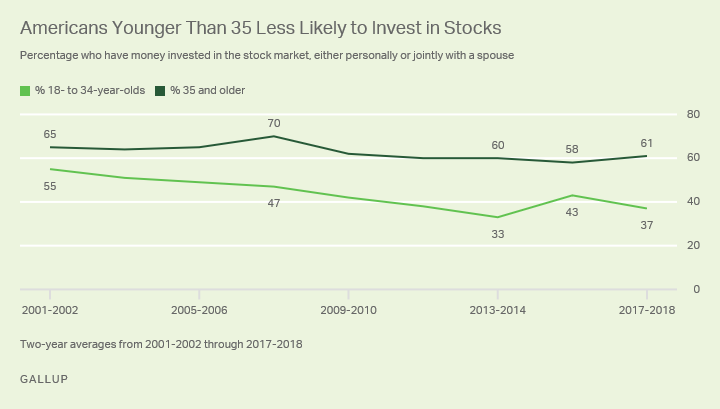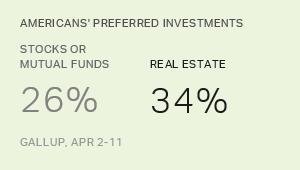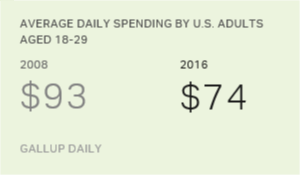Story Highlights
- Only 37% of those younger than 35 invest in stock market
- A majority of those under 35 had stocks before 2008 market crash
- Middle-income young Americans much more leery of market now
WASHINGTON, D.C. -- A decade after stockholders lost trillions of dollars in the crash of 2008, younger Americans are still leery of investing their money in stocks. Though the stock market has climbed far above pre-crash levels, the combined percentage of adults younger than 35 with money in the stock market in 2017 and 2018 stands at 37%, down from 52% for people in that age range in the two years (2006-07) leading up to the crash.
A look at combined two-year averages from 2001 through this year, which provide large enough samples for meaningful analysis, shows the toll that the crash took on younger Americans' confidence in stocks. The percentage owning stocks, which was already dropping in the years before the crash, reached a low of 33% in 2013-14 before rebounding somewhat in recent years. Over the same period, stock ownership among those 35 and older has never fallen below 58% in the two-year averages, and stands at 61% for the past two years.

Overall, an average of 52% of those younger than 35 said they owned stocks in Gallup's annual Economy and Personal Finance Surveys for the seven years (2001-07) leading up to the crash. The average has dropped to 38% for the 11 years that followed (2008-18). Among those 35 and older, the pre-crash average was 66%, and the post-crash average is 61%.
Younger Americans owning stocks in the first few years of this century did so against the background of a 1990s stock boom that saw the Dow Jones industrial average more than quadruple in value. Despite some market turbulence over the next few years, the percentage of those under 35 with stocks dropped only moderately. However, after the crash of 2008, when the Dow Jones fell more than 50% from the end of 2007 to mid-March 2009, the ranks of those under 35 owning stock shrank steadily for the next several years. After growing to 43% in 2015-16, the past two years have seen a drop to 37% as the market showed strong growth but considerable volatility -- including some major declines this year.
Stock Ownership Has Fallen Most Among Middle-Income Younger Americans
For those aged 18 to 34, the drop in stock ownership from before the 2008 crash to today does not vary greatly by gender or education. Differences are more pronounced by income, with the most significant changes occurring among those in the middle-income bracket -- those with annual household incomes of at least $30,000 but less than $75,000.
| 2001-2007 | 2008-2018 | Change | ||||||||||||||||||||||||||||||||||||||||||||||||||||||||||||||||||||||||||||||||||||||||||||||||||
|---|---|---|---|---|---|---|---|---|---|---|---|---|---|---|---|---|---|---|---|---|---|---|---|---|---|---|---|---|---|---|---|---|---|---|---|---|---|---|---|---|---|---|---|---|---|---|---|---|---|---|---|---|---|---|---|---|---|---|---|---|---|---|---|---|---|---|---|---|---|---|---|---|---|---|---|---|---|---|---|---|---|---|---|---|---|---|---|---|---|---|---|---|---|---|---|---|---|---|---|---|
| % | % | pct. pts. | ||||||||||||||||||||||||||||||||||||||||||||||||||||||||||||||||||||||||||||||||||||||||||||||||||
| All Americans | 52 | 38 | -14 | |||||||||||||||||||||||||||||||||||||||||||||||||||||||||||||||||||||||||||||||||||||||||||||||||
| Annual household income | ||||||||||||||||||||||||||||||||||||||||||||||||||||||||||||||||||||||||||||||||||||||||||||||||||||
| Less than $30,000 | 25 | 18 | -7 | |||||||||||||||||||||||||||||||||||||||||||||||||||||||||||||||||||||||||||||||||||||||||||||||||
| $30,000-$74,999 | 62 | 41 | -21 | |||||||||||||||||||||||||||||||||||||||||||||||||||||||||||||||||||||||||||||||||||||||||||||||||
| $75,000 and above | 78 | 66 | -12 | |||||||||||||||||||||||||||||||||||||||||||||||||||||||||||||||||||||||||||||||||||||||||||||||||
| Gender | ||||||||||||||||||||||||||||||||||||||||||||||||||||||||||||||||||||||||||||||||||||||||||||||||||||
| Male | 55 | 41 | -14 | |||||||||||||||||||||||||||||||||||||||||||||||||||||||||||||||||||||||||||||||||||||||||||||||||
| Female | 49 | 36 | -13 | |||||||||||||||||||||||||||||||||||||||||||||||||||||||||||||||||||||||||||||||||||||||||||||||||
| Education | ||||||||||||||||||||||||||||||||||||||||||||||||||||||||||||||||||||||||||||||||||||||||||||||||||||
| No college | 36 | 22 | -14 | |||||||||||||||||||||||||||||||||||||||||||||||||||||||||||||||||||||||||||||||||||||||||||||||||
| Some college | 52 | 37 | -15 | |||||||||||||||||||||||||||||||||||||||||||||||||||||||||||||||||||||||||||||||||||||||||||||||||
| College graduate | 74 | 64 | -10 | |||||||||||||||||||||||||||||||||||||||||||||||||||||||||||||||||||||||||||||||||||||||||||||||||
| Postgraduate work | 80 | 69 | -11 | |||||||||||||||||||||||||||||||||||||||||||||||||||||||||||||||||||||||||||||||||||||||||||||||||
| GALLUP | ||||||||||||||||||||||||||||||||||||||||||||||||||||||||||||||||||||||||||||||||||||||||||||||||||||
Safe Investments Hold Special Appeal to Young Americans
On average, about a fourth (26%) of younger Americans in Gallup's 2017 and 2018 surveys have said the stock market is the best of five possible long-term investments -- the same percentage as older Americans. Those 18 to 34 are much more likely than are those 35 and older to see savings accounts and CDs as the best choice, while older Americans are more likely to favor gold.
| 18 to 34 | 35 and older | ||||||||||||||||||||||||||||||||||||||||||||||||||||||||||||||||||||||||||||||||||||||||||||||||||
|---|---|---|---|---|---|---|---|---|---|---|---|---|---|---|---|---|---|---|---|---|---|---|---|---|---|---|---|---|---|---|---|---|---|---|---|---|---|---|---|---|---|---|---|---|---|---|---|---|---|---|---|---|---|---|---|---|---|---|---|---|---|---|---|---|---|---|---|---|---|---|---|---|---|---|---|---|---|---|---|---|---|---|---|---|---|---|---|---|---|---|---|---|---|---|---|---|---|---|---|
| % | % | ||||||||||||||||||||||||||||||||||||||||||||||||||||||||||||||||||||||||||||||||||||||||||||||||||
| Real estate | 32 | 35 | |||||||||||||||||||||||||||||||||||||||||||||||||||||||||||||||||||||||||||||||||||||||||||||||||
| Stocks, mutual funds | 26 | 26 | |||||||||||||||||||||||||||||||||||||||||||||||||||||||||||||||||||||||||||||||||||||||||||||||||
| Savings accounts, CDs | 21 | 11 | |||||||||||||||||||||||||||||||||||||||||||||||||||||||||||||||||||||||||||||||||||||||||||||||||
| Gold | 11 | 20 | |||||||||||||||||||||||||||||||||||||||||||||||||||||||||||||||||||||||||||||||||||||||||||||||||
| Bonds | 7 | 5 | |||||||||||||||||||||||||||||||||||||||||||||||||||||||||||||||||||||||||||||||||||||||||||||||||
| Gallup polls, April 5-9, 2017, and April 2-11, 2018 (combined averages) | |||||||||||||||||||||||||||||||||||||||||||||||||||||||||||||||||||||||||||||||||||||||||||||||||||
Bottom Line
Americans who are now 18 to 34 years old were between the ages of eight and 24 when the stock market crashed in 2008. Those aged 25 to 34, who have more income to invest than those under 25 and are therefore more likely to own stocks, were in their teens or older -- ages when many would have seen and understood the effects the crash had on Americans' confidence in the stock market as an investment.
Older Americans, who had seen the market recover from previous shocks, have been more willing to hold on to their stocks and see what happens in the long run. So far, that approach has appeared to pay off. Though the market has been through some spectacular drops and volatility earlier this year, the Dow Jones industrial average has more than tripled in the past nine years.
Survey Methods
Results for this Gallup poll are based on interviews for Gallup's Economy and Personal Finance polls, conducted annually in April from 2001 through 2018, with random samples of 1,003 to 2,017 adults, aged 18 and older, living in all 50 U.S. states and the District of Columbia. For results based on the total sample of national adults, the margin of sampling error is ±4 percentage points at the 95% confidence level. For results based on the two-year averages for total samples of adults 18 to 34 years old, the margin of sampling error is ±5 to ±7 percentage points at the 95% confidence level. All reported margins of sampling error include computed design effects for weighting.
Landline and cellular telephone numbers are selected using random-digit-dial methods.
View survey methodology, complete question responses and trends.
Learn more about how the Gallup Poll Social Series works.





